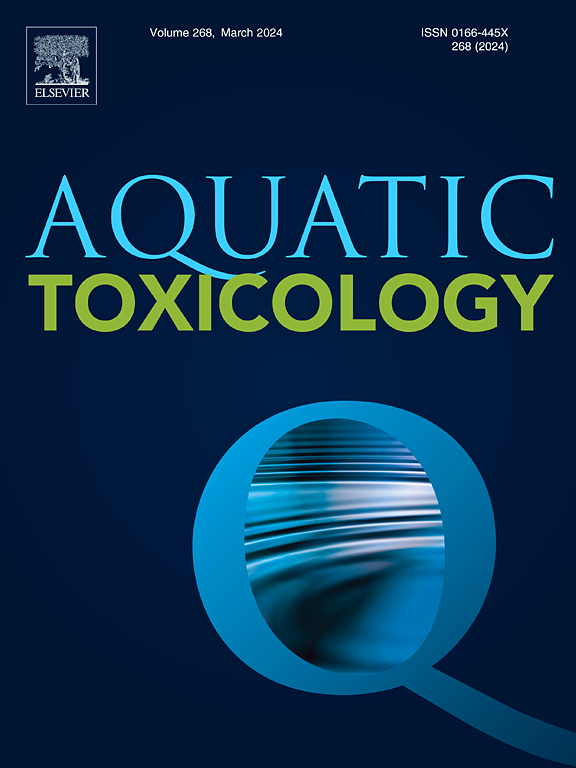Antibacterials exert toxic effects on aquatic organisms by inhibiting respiration, inducing oxidative stress, mitochondrial dysfunction and autophagy
IF 4.1
2区 环境科学与生态学
Q1 MARINE & FRESHWATER BIOLOGY
引用次数: 0
Abstract
Although bactericidal antibiotics are an integral part of infectious disease medicine, the uncontrolled use of these drugs in recent years is beginning to affect the environment, especially water resources. With the exception of a few well-documented toxic effects, antimicrobials are thought to act mainly on bacteria and, at low doses, have no deleterious effects on eukaryotic organisms. However, since mitochondria are direct ancient relatives of prokaryotes, mitochondrial dysfunction induced by antibiotic exposure can also occur in higher eukaryotes. In this work, we used the microcrustacean Artemia salina to show how some known antibacterial drugs exert toxic effects on mitochondria, suppressing cellular and organismal respiration in aquatic organisms. We have demonstrated that exposure to antimicrobials of different classes, namely kanamycin A, tetracycline hydrochloride, erythromycin, and chloramphenicol, leads to the accumulation of reactive oxygen species and is accompanied by autophagy. Our results suggest that the emergence of antibactericidal drugs, increasingly appearing in wastewater, may have far-reaching consequences for aquatic areas adjacent to large cities.

抗菌药物通过抑制呼吸、诱导氧化应激、线粒体功能障碍和自噬对水生生物产生毒性作用
虽然杀菌抗生素是传染病医学的一个组成部分,但近年来这些药物的不受控制的使用开始影响环境,特别是水资源。除了一些有充分证据的毒性作用外,抗菌剂被认为主要作用于细菌,在低剂量下,对真核生物没有有害作用。然而,由于线粒体是原核生物的直接古老亲属,抗生素暴露诱导的线粒体功能障碍也可能发生在高等真核生物中。在这项工作中,我们使用了微甲壳类动物Artemia salina来展示一些已知的抗菌药物如何对线粒体产生毒性作用,抑制水生生物的细胞和有机体呼吸。我们已经证明,暴露于不同类别的抗菌剂,即卡那霉素A、盐酸四环素、红霉素和氯霉素,会导致活性氧的积累,并伴有自噬。我们的研究结果表明,抗菌药物的出现,越来越多地出现在废水中,可能对大城市附近的水域产生深远的影响。
本文章由计算机程序翻译,如有差异,请以英文原文为准。
求助全文
约1分钟内获得全文
求助全文
来源期刊

Aquatic Toxicology
环境科学-毒理学
CiteScore
7.10
自引率
4.40%
发文量
250
审稿时长
56 days
期刊介绍:
Aquatic Toxicology publishes significant contributions that increase the understanding of the impact of harmful substances (including natural and synthetic chemicals) on aquatic organisms and ecosystems.
Aquatic Toxicology considers both laboratory and field studies with a focus on marine/ freshwater environments. We strive to attract high quality original scientific papers, critical reviews and expert opinion papers in the following areas: Effects of harmful substances on molecular, cellular, sub-organismal, organismal, population, community, and ecosystem level; Toxic Mechanisms; Genetic disturbances, transgenerational effects, behavioral and adaptive responses; Impacts of harmful substances on structure, function of and services provided by aquatic ecosystems; Mixture toxicity assessment; Statistical approaches to predict exposure to and hazards of contaminants
The journal also considers manuscripts in other areas, such as the development of innovative concepts, approaches, and methodologies, which promote the wider application of toxicological datasets to the protection of aquatic environments and inform ecological risk assessments and decision making by relevant authorities.
 求助内容:
求助内容: 应助结果提醒方式:
应助结果提醒方式:


